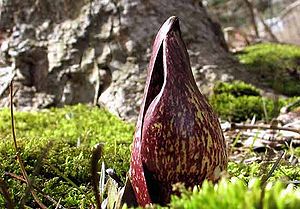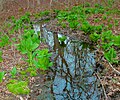Symplocarpus foetidus
| Symplocarpus foetidus | ||||||||||||
|---|---|---|---|---|---|---|---|---|---|---|---|---|

Symplocarpus foetidus |
||||||||||||
| Systematics | ||||||||||||
|
||||||||||||
| Scientific name | ||||||||||||
| Symplocarpus foetidus | ||||||||||||
| Salisb. |
Symplocarpus foetidus well as some other types Skunk Cabbage ( English skunk cabbage called), is a species of the genus Symplocarpus within the family of the arum family (Araceae). It grows in wetlands in North America. It belongs to the early bloomers .
Common names
According to their smell, some common names are used: skunk cabbage , but also dragon weed or ball butt ; engl .: eastern skunk cabbage , swamp cabbage , clumpfoot cabbage , meadow cabbage , foetid pothos , polecat weed , in Quebec : chou puant .
description
Vegetative characteristics
Symplocarpus foetidus grows as a pre-summer green, perennial , herbaceous plant and reaches heights of up to 70 centimeters. An underground tuber with a diameter of up to 30 centimeters serves as a storage and persistence organ . The terminal shoot bud arises from a scale.
The leaves are only formed after the flowering period . The leaves are 40–55 centimeters long and 30–40 centimeters wide.
Generative characteristics
The inflorescence has the typical structure of Araceae and consists of spathe and cobs. The spathe envelops the piston and is 10-15 centimeters long and speckled purple. The flowers sit on a bulb with a length of 5–10 centimeters. There are four stamens present
The hard seeds are pea-sized and spherical.
ecology
When parts of plants are damaged, they give off a pungent odor that gives this species of plant its name. The plant is not poisonous when touched. The carrion odor of the flowers attracts the pollinating insects, especially carrion flies , stone flies of the Nemouridae family and bees . The smell of the leaves should also serve to deter herbivores. Symplocarpus foetidus is known for its ability to generate temperatures up to 15–35 ° C (27–63 ° F) above the ambient temperature. He achieves this increase in temperature through cyanide-resistant respiration (a special, alternative electron transport path that occurs in plants and many yeasts), which the plant makes its way through frozen mud and ice. It belongs to a small group of heat-generating plants. Therefore, even in winter conditions, the plant is successfully pollinated by early insects. Especially the carrion flies should also be attracted by the heat.
The stinking cabbage has contracting roots that, after growing into the ground, contract and pull the plant deeper into the ground. It's almost impossible to dig up an older plant.
The seeds fall to the ground and are spread by animals or floods.
Spread and endangerment
Symplocarpus foetidus is widespread in North America from Nova Scotia and southern Québec west to Minnesota and south to North Carolina and Tennessee . In Tennessee, Symplocarpus foetidus is considered "endangered".
Taxonomy
The first publication of Symplocarpus foetidus was by Richard Anthony Salisbury . Synonyms for Symplocarpus foetidus Salisb. are: Dracontium foetidum L. , Spathyema foetida (L.) Raf. , Pothos foetidus (L.) Aiton , Ictodes foetidus (L.) Bigelow , Pothos putorii Barton , Spathyema angusta Raf. , Spathyema lanceolata Raf. , Spathyema latifolia Raf. , Symplocarpus foetidus f. variegatus Otsuka .
The specific epithet foetidus means "smelly".
gallery
Habitat of Symplocarpus foetidus and flowering Marsh marigold ( Caltha palustris )
use
In the 19th century, the American pharmacopoeia listed "Eastern Skunk Cabbage" as the drug "dracontium". It was used in the treatment of respiratory diseases , nervous disorders , rheumatism and edema . In North America and Europe, skunk cabbage is occasionally grown in water gardens . American Indians used Symplocarpus foetidus as medicine, spice and magical amulet . While Symplocarpus foetidus cannot be eaten raw because the leaves can burn the mucous membranes and the roots are poisonous, dried leaves can be used in soups and stews.
Individual evidence
- ↑ a b USDA data sheet.
- ^ A b c Katherine K. Thorington: Pollination and Fruiting Success in the Eastern Skunk Cabbage . In: The Journal of Biospheric Science . tape 2 , no. May 1 , 2000 ( mtholyoke.edu ).
- ↑ Janet Marinelli, Turning Up the Heat on Your Property. In: nwf.org. National Wildlife Federation, January 12, 2006, accessed May 12, 2016 .
- ^ Graham Rice: The flowering of Symplocarpus . In: The Plantsman, March 2012, pp. 54–57 ( PDF ).
- ^ Sue A. Thompson: Araceae. : Symplocarpus foetidus - the same text online as the printed work , In: Flora of North America Editorial Committee (Hrsg.): Flora of North America North of Mexico. Volume 22: Magnoliophyta: Alismatidae, Arecidae, Commelinidae (in part), and Zingiberidae , Oxford University Press, New York and Oxford, 2000, ISBN 0-19-513729-9 .
- ↑ Dr. Moerman's Native American Ethnobotanical Database : Symplocarpus foetidus ( Memento of the original from July 15, 2012 in the web archive archive.today ) Info: The archive link was automatically inserted and not yet checked. Please check the original and archive link according to the instructions and then remove this notice.
- ↑ Melanie Choukas-Bradley: Wildflower in Focus: Skunk Cabbage ( Memento July 7, 2009 in the Internet Archive ). Maryland Native Plant Society.
Web links
- Symplocarpus foetidus in the Germplasm Resources Information Network (GRIN), USDA , ARS , National Genetic Resources Program. National Germplasm Resources Laboratory, Beltsville, Maryland.
- Sue A. Thompson: Araceae. : Symplocarpus foetidus - the same text online as the printed work , In: Flora of North America Editorial Committee (Hrsg.): Flora of North America North of Mexico. Volume 22: Magnoliophyta: Alismatidae, Arecidae, Commelinidae (in part), and Zingiberidae , Oxford University Press, New York and Oxford, 2000, ISBN 0-19-513729-9 .
- Kew World Checklist of Selected Plant Families



